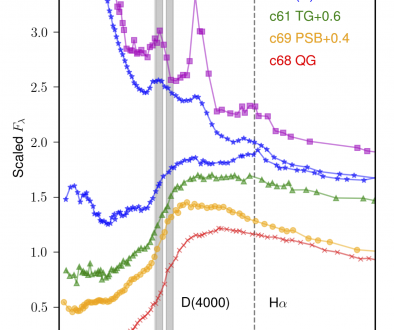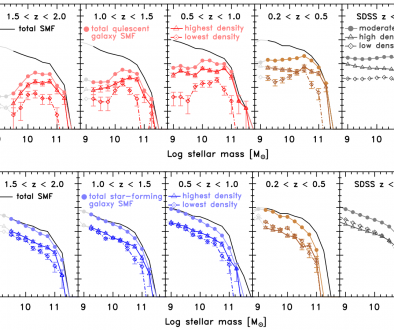Kawinwanichakij 2015 Summary
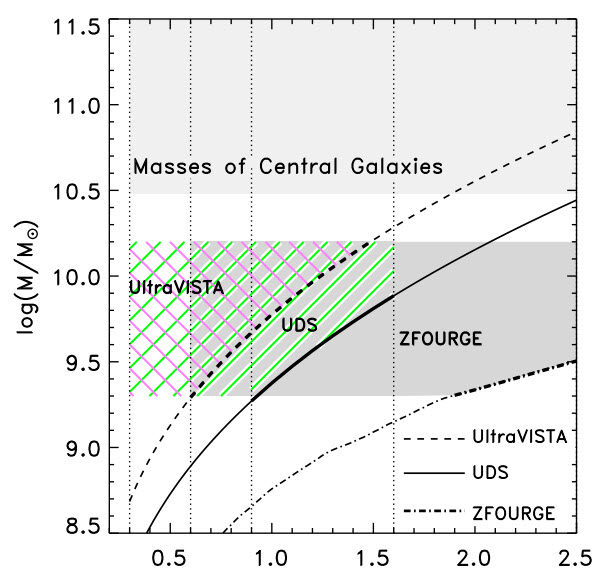 We study the evolution of galactic conformity with redshift out to z = 2.5. Galactic conformity has been observed in the local universe as a correlation between the star formation activity of centrals and their satellites. The correlation is such that the quiescent fraction of satellites is higher around quiescent central galaxies than around star-forming centrals. We measure the quiescent fraction and quenching efficiency of satellites around star-forming and quiescent central galaxies with log(M_cen/M_sol) > 10.5 at 0.3 < z < 2.5. We use data from three different deep near-IR surveys ZFOURGE/CANDELS, UDS, and UltraVISTA that span different ranges of depth and area in order to achieve significant volume at lower redshifts as well as sufficient depth for high redshift measurements. As described by Kawinwanichakij et al. 2014, we identify satellites using statistical background subtraction technique. We find that satellite galaxies, 9.3 < log(M_sat/M_sol) < 10.2 are more quenched compared to mass-matched samples of field galaxies. In our sample, the conformity signal is significant at > 3sigma for 0.6 < z < 1.6, whereas it is only weakly significant at 0.3 < z < 0.6 and 1.6 < z < 2.5. We test if galactic conformity is due to a difference in the typical halo mass of star-forming and quiescent centrals. We find that the difference in halo mass can explain most of the conformity signal in our data. However, there still remains evidence for conformity, particularly at 0.6 < z < 0.9. This suggests that satellite quenching is connected to the star-formation properties of the central, beyond the mass of the halo.
We study the evolution of galactic conformity with redshift out to z = 2.5. Galactic conformity has been observed in the local universe as a correlation between the star formation activity of centrals and their satellites. The correlation is such that the quiescent fraction of satellites is higher around quiescent central galaxies than around star-forming centrals. We measure the quiescent fraction and quenching efficiency of satellites around star-forming and quiescent central galaxies with log(M_cen/M_sol) > 10.5 at 0.3 < z < 2.5. We use data from three different deep near-IR surveys ZFOURGE/CANDELS, UDS, and UltraVISTA that span different ranges of depth and area in order to achieve significant volume at lower redshifts as well as sufficient depth for high redshift measurements. As described by Kawinwanichakij et al. 2014, we identify satellites using statistical background subtraction technique. We find that satellite galaxies, 9.3 < log(M_sat/M_sol) < 10.2 are more quenched compared to mass-matched samples of field galaxies. In our sample, the conformity signal is significant at > 3sigma for 0.6 < z < 1.6, whereas it is only weakly significant at 0.3 < z < 0.6 and 1.6 < z < 2.5. We test if galactic conformity is due to a difference in the typical halo mass of star-forming and quiescent centrals. We find that the difference in halo mass can explain most of the conformity signal in our data. However, there still remains evidence for conformity, particularly at 0.6 < z < 0.9. This suggests that satellite quenching is connected to the star-formation properties of the central, beyond the mass of the halo.
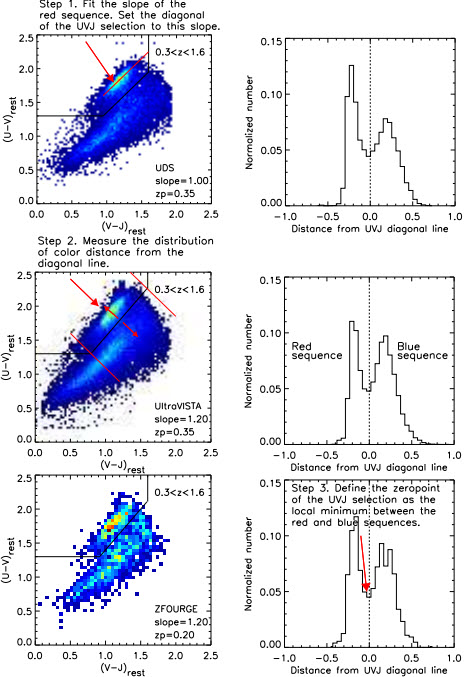 The evolution of the average quiescent fraction of satellites around quiescent centrals (red) and star-forming centrals (blue) from three datasets: ZFOURGE, UKIDSS UDS, and UltraVISTA. For all fields and redshift ranges, we see evidence for higher quiescent fractions for satellites around quiescent centrals compared to satellites around star-forming centrals at fixed stellar mass.
The evolution of the average quiescent fraction of satellites around quiescent centrals (red) and star-forming centrals (blue) from three datasets: ZFOURGE, UKIDSS UDS, and UltraVISTA. For all fields and redshift ranges, we see evidence for higher quiescent fractions for satellites around quiescent centrals compared to satellites around star-forming centrals at fixed stellar mass.
The average quiescent fraction of satellites around quiescent centrals and star-forming centrals combining from the three datasets. The average quiescent fraction of background galaxies of the same stellar masses are also shown. Although satellites are quenched over time, we see strong evidence that satellites have excess quenching above similar galaxies in the field regardless of the activity of their central galaxy. The conformity signal is significant at > 3 sigma for 0.6 < z < 1.6, whereas it is only weakly significant at 0.3 < z < 0.6 and 1.6 < z < 2.5.
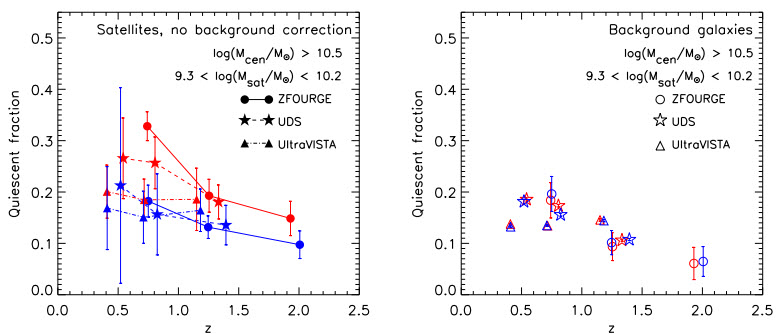 The average quenching efficiency of satellites after approximately matching the halo masses of the quiescent and star-forming centrals using all three datasets. As we showed in a previous study (Kawinwanichakij et al. 2014), the increase in satellites corresponds to a comparable increase in halo mass. We find that the mean number of satellites is about equal for quiescent centrals with 10.4 < log(M_cen/M_sol) < 10.7 ,and star-forming centrals with 10.6 < log(M_cen/M_sol) < 10.9, implying they have approximately the same halo mass. The quenching efficiency of satellites of quiescent and star- forming centrals are about the same at all redshift (except at 0.6 < z < 0.9) after we matched the mean number of satellites/halo masses of quiescent and star-forming centrals. Therefore, the galactic conformity observed in our galaxy sample is mainly driven by the halo mass. However, at 0.6 < z < 0.9, the conformity is due to central galaxies being quiescent rather than just the halo mass of centrals.
The average quenching efficiency of satellites after approximately matching the halo masses of the quiescent and star-forming centrals using all three datasets. As we showed in a previous study (Kawinwanichakij et al. 2014), the increase in satellites corresponds to a comparable increase in halo mass. We find that the mean number of satellites is about equal for quiescent centrals with 10.4 < log(M_cen/M_sol) < 10.7 ,and star-forming centrals with 10.6 < log(M_cen/M_sol) < 10.9, implying they have approximately the same halo mass. The quenching efficiency of satellites of quiescent and star- forming centrals are about the same at all redshift (except at 0.6 < z < 0.9) after we matched the mean number of satellites/halo masses of quiescent and star-forming centrals. Therefore, the galactic conformity observed in our galaxy sample is mainly driven by the halo mass. However, at 0.6 < z < 0.9, the conformity is due to central galaxies being quiescent rather than just the halo mass of centrals.
